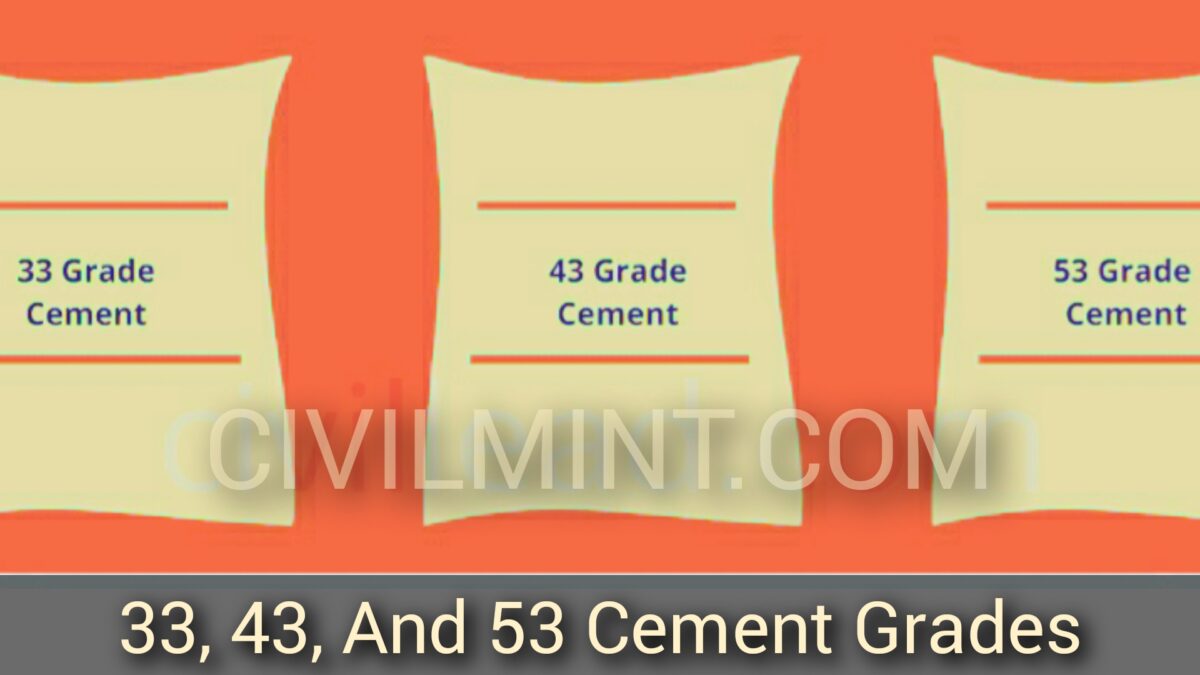In this blog post, I will discuss 33, 43, and 53 cement grade.

Comparison Between 33, 43, And 53 Grade Of Cement
Learn all the differences between 33, 43 and 53 grade of cement.
| 33 Grade Cement | 43 Grade Cement | 53 Grade Cement |
|---|---|---|
| Lower Strength | Medium Strength | Higher Strength |
| Weaker | Stronger | Strongest |
| Used for Non-structural Purposes | Used for General Construction | Used for Heavy Construction |
| Sets Slowly | Sets at Moderate Speed | Sets Quickly |
| Lower Durability | Good Durability | High Durability |
| Not Suitable for Large Structures | Suitable for Most Structures | Suitable for High-rise Buildings |
| Lower Heat of Hydration | Moderate Heat of Hydration | Higher Heat of Hydration |
| Lower Cost | Moderate Cost | Higher Cost |
| Used for Basic Construction Projects | Used for Common Construction Projects | Used for Complex Construction Projects |
| Lower Resistance to External Elements | Better Resistance to External Elements | Excellent Resistance to External Elements |
| Lower Initial Setting Time | Moderate Initial Setting Time | Faster Initial Setting Time |
| Used for Small-scale Construction | Used for Medium-scale Construction | Used for Large-scale Construction |
| Lower Ultimate Strength | Higher Ultimate Strength | Highest Ultimate Strength |
| Less Binding Power | Good Binding Power | Excellent Binding Power |
| Used for Non-load-bearing Structures | Used for Load-bearing Structures | Used for High-load Structures |
| Not Suitable for High-traffic Areas | Suitable for Most Traffic Areas | Suitable for Heavy Traffic Areas |
| Lower Resistance to Chemicals | Moderate Resistance to Chemicals | Higher Resistance to Chemicals |
| Lower Fineness | Moderate Fineness | Higher Fineness |
| Not Ideal for Reinforced Structures | Suitable for Reinforced Structures | Ideal for Reinforced Structures |
| Lower Expansion | Moderate Expansion | Higher Expansion |
Table of Contents
What Is 33 Grade Cement?
This cement grade is not commonly used nowadays. It means that after 28 days, the cement can withstand a pressure of 33 Newton per square millimeter (N/mm²).
It is suitable for general construction work in normal conditions. However, it may not be good for concrete that needs to be very strong, like when building big structures.
What Is 43 Grade Cement?
This cement grade is used for plain concrete work and plastering. It means that after 28 days, the cement can withstand a pressure of 43 N/mm².
It is good for making concrete up to a certain strength called M30. It is also used to make things like tiles, blocks, and pipes.
What Is 53 Grade Cement?
This is a strong cement grade used for important structures. It means that after 28 days, the cement can withstand a pressure of 53 N/mm².
It sets quickly compared to 43 grade cement. It is used for making concrete above a strength called M25 and for special types of concrete like prestressed concrete.
Faqs
There are three kinds of cement: 33, 43, and 53. These numbers show how strong the cement is after it dries.
33 grade cement is good for basic things like making walls, floors, and plaster. It’s not very strong, but it works well for simple projects.
We use 43 grade cement when we want stronger buildings. It’s used for things like big houses and buildings with beams and columns.
53 grade cement is extra strong! We use it for really big and tough structures like bridges, tall buildings, and dams. It doesn’t break easily under lots of weight or pressure.
It’s not a good idea to use the strongest cement for every project. Sometimes it’s too much and costs more money. It can also make the cement harder to work with. It’s better to use the right cement for each job, as suggested by the experts.
